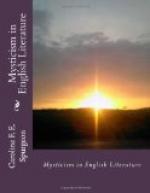For the sake of clearness, this thought may first be traced very briefly as it appears chronologically; it will, however, be considered in detail, not in order of time, but according to the special aspect of Being through which the writer felt most in touch with the divine life. For mystics, unlike other thinkers, scientific or philosophical, have little chronological development, since “mystic truths can neither age nor die.” So much is this the case that passages of Plotinus and Tennyson, of Boehme and Law, of Eckhart and Browning, may be placed side by side and be scarcely distinguishable in thought. Yet as the race evolves, certain avenues of sensation seem to become more widely opened up. This is noticeable with regard to Nature. Love, Beauty, Wisdom, and Devotion, these have been well-trodden paths to the One ever since the days of Plato and Plotinus; but, with the great exception of St Francis of Assisi and his immediate followers, we have to wait for more modern times before we find the intense feeling of the Divinity in Nature which we associate with the name of Wordsworth. It is in the emphasis of this aspect of the mystic vision that English writers are supreme. Henry Vaughan, Wordsworth, Browning, Richard Jefferies, Francis Thompson, and a host of other poet-seers have crystallised in immortal words this illuminated vision of the world.
The thought which has been described as mystical has its roots in the East, in the great Oriental religions. The mysterious “secret” taught by the Upanishads is that the soul or spiritual consciousness is the only source of true knowledge. The Hindu calls the soul the “seer” or the “knower,” and thinks of it as a great eye in the centre of his being, which, if he concentrates his attention upon it, is able to look outwards and to gaze upon Reality. The soul is capable of this because in essence it is one with Brahman, the universal soul. The apparent separation is an illusion wrought by matter. Hence, to the Hindu, matter is an obstruction and a deception, and the Eastern mystic despises and rejects and subdues all that is material, and bends all his faculties on realising his spiritual consciousness, and dwelling in that.
This type of thought certainly existed to some extent in both Greece and Egypt before the Christian era. Much of Plato’s thought is mystical in essence, and that which be points out to be the motive force of the philosophic mind is also the motive force of the mystic, namely, the element of attraction, and so of love towards the thing which is akin to him. The illustration of the dog being philosophic because he is angry with a stranger but welcomes his friend,[3] though at first it may seem, like many of Plato’s illustrations, far-fetched or fanciful, in truth goes to the very root of his idea. Familiarity, akinness, is the basis of attraction and affection. The desire of wisdom, or the love of beauty, is therefore nothing but the yearning of the soul to join itself




